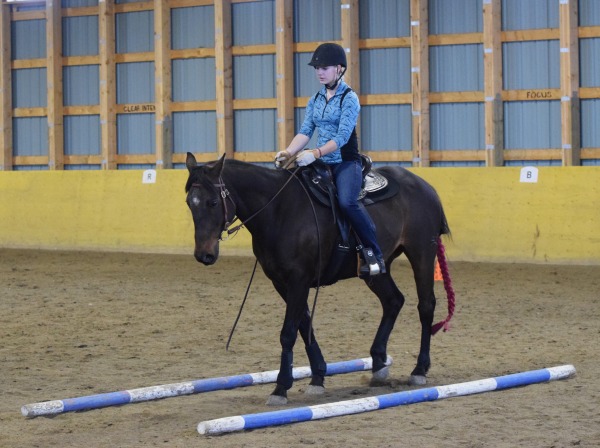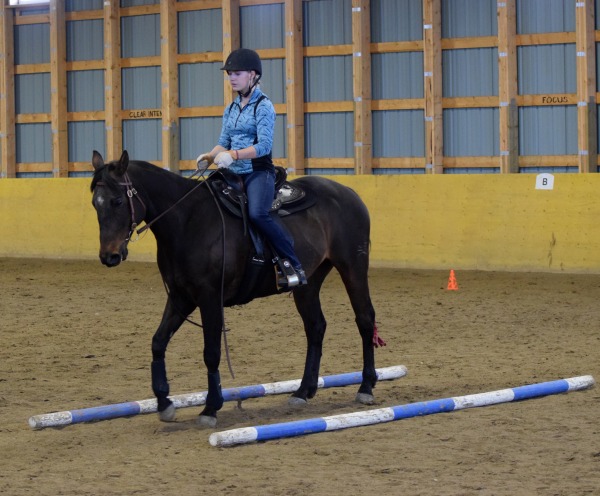Rebalancing on a serpentine. By Lisa Wieben and Birgit Stutz
In the last blog post we discussed a rebalance exercise on the circle. In this blog post we will take that same rebalancing exercise out into the arena onto a serpentine. For this exercise the rider will need to be familiar with riding a three-loop serpentine.
Start by warming up your horse on random bending lines in the walk and working jog (posting). The changes of bend will begin to supple the horse’s ribcage and frequent transitions will encourage hind end engagement. All transitions should be on bending lines in the warm-up to prevent the horse from leaning on the bit, inverting (lifting the head above the withers), or getting heavy in the front.
Many horses, when doing a transition on a straight line, will lift the head and pull themselves forward, rather than keeping the head level, pushing from behind, and lifting the back and withers. To get an image of how a horse should move forward imagine a power boat starting forward. The back of the boat sinks down as the front of the boats lift up. The power is in the back. For the horse, if the hind end is lacking power and the legs are out behind, the horse inverts (hollows its back and lifts its head), and pulls forward from the front end. This would be equivalent to someone in the front of the boat paddling to get the boat to go forward – there is no power. The person paddling will likely get a sore back from the effort and your horse will also become tight and sore in his back from the hollowing. Saddle fit will also change if your horse is lifting his back correctly. The ultimate goal of collection is developing the horse, over time, to carry more weight on his hind end and lighten the forehand.
The following exercise as well as the previous rebalance exercise are great ways to start teaching the horse this transfer of weight.
For this exercise you will be riding a three-loop serpentine in both directions of the arena. In our last exercise we used transition points on the circle to create a little anticipation in the horse, which allows us to use more leg to tell the horse “not yet” when they want to do the downward transitions on their own. In this exercise the transition points will be just before and after the centre line of the arena.

Riding the half circle of a serpentine.
Begin the first serpentine in a working jog (posting) and ride through the entire serpentine to get the feel of the half circles and straight lines across the centre of the arena. When you reach the end of the arena proceed back up the arena again in a three-loop serpentine. This time, just before the centre line, ask the horse to come back to a walk by inhaling, growing tall (creating a feeling of lightness in your body tells the horse a change is coming), exhaling and sinking down. Make sure to maintain straightness in your body, no leaning forward or back, legs close to the horse to maintain straightness and forward energy into the walk. There should be no feeling of ‘halt’ in a downward walk transition. Allow the horse to walk forward a few steps, begin to change bend onto the new arc of the serpentine, and ask the horse back to a jog, maintaining light contact throughout the transitions. Repeat on the next straight line, bringing the horse to a walk across the centre line, walking a few steps, changing bend into the new arc and jogging forward. Repeat this transition until the horse begins to anticipate the downward walk transition.

Entering the straight portion of the serpentine. The 12′ poles maintain straightness through the centre.
Once the horse is thinking ‘slow down’, begin to ask for a halt transition at each centre point of the serpentine. You could also add a transition on each short side as well, at A and C. For the halt transition use the same breathing of inhaling and growing tall and exhaling and sinking down, but this time stop your seat from following, giving the horse the cue to stop. Maintain leg contact into the halt to keep the halt straight. Keep your eyes lifted and body tall to keep the horse light on the forehand.

Transitioned to the walk at the start of the poles. The rider will then begin the working jog as she leaves the poles.
Once the horse begins to anticipate the halt, then you can repeat the serpentine using a slight rebalance at each centre line. Keep the horse in working jog and as you approach the centre line, slow your posting and ask the horse to ‘come back’ very slightly in his gait. Only ask for a couple of steps, then immediately ask the horse to go forward again by increasing the tempo of your rising. Maintain contact throughout the rebalance, especially as the horse goes forward again, to prevent the horse from lifting the head and pulling forward. You want to feel a push from behind.

Transitioning to a halt. Notice the rider’s hands lifting slightly.
To make this exercise more interesting you can add trot poles at each centre line transition point. When adding poles just use the two points on the centre line and not A and C. You can use the rebalance before the poles to adjust speed and length of stride and after to adjust speed and balance. Some horses will get excited when adding poles. Go one step further and place your poles at different distances. For example, place the first set at just under one metre or (three feet) apart and the second set at just over a metre (3’6”) apart. With poles set at different distances you can use the rebalance to set your horse’s stride length. Experiment with different distances and placements of poles. Have fun!

A square halt shows the horse is halting balanced. The rider kept both legs on the horse to maintain straightness and to keep both hind legs stepping under.
This article is the 27th in a series of articles on Western dressage and is a collaboration between Lisa Wieben (see biography below) and Birgit Stutz. The articles appear in the horse magazine SaddleUp on a monthly basis.
Photos by Lisa Wieben. Rider Jacklyn Hegberg and her horse Cash.
Lisa Wieben is a Level 2 Centered Riding Instructor, EC Coach, and Irwin Insights Level 4 Master Certified Trainer. Specializing in Western and English Dressage, she coaches near Bowden/Olds, AB. Lisa is also a Hanna Somatic Instructor and Practitioner in Training, working with riders, in class or privately, to learn movement exercises that target specific muscle issues in the body brought on by stress, injuries, surgeries, and overuse. A balanced rider equals a balanced horse. www.mountainviewtrainingstables.com.
Birgit Stutz is an Irwin Insights Level 4 Master Certified Trainer and offers horse training, lessons (English and Western), clinics, mentorship programs, horsemanship courses, workshops, short courses and demos on various topics, and working student programs at Falling Star Ranch Academy of Foundational Horsemanship in Dunster, BC. Birgit’s passion is to help humans have a better relationship with their horses through understanding of equine psychology, body language, biomechanics, as well as fundamental riding skills. www.fallingstarranch.ca.